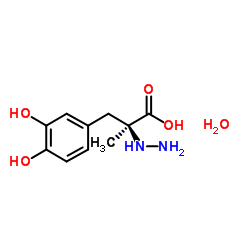Carbidopa monohydrate

Carbidopa monohydrate structure
|
Common Name | Carbidopa monohydrate | ||
|---|---|---|---|---|
| CAS Number | 38821-49-7 | Molecular Weight | 244.244 | |
| Density | 1.42 g/cm3 | Boiling Point | 528.7ºC at 760 mmHg | |
| Molecular Formula | C10H16N2O5 | Melting Point | N/A | |
| MSDS | Chinese USA | Flash Point | 273.5ºC | |
| Symbol |

GHS07 |
Signal Word | Warning | |
Use of Carbidopa monohydrateCarbidopa ((S)-(-)-Carbidopa) monohydrate, a peripheral decarboxylase inhibitor, can be used for the research of Parkinson's disease. Carbidopa monohydrate is a selective aryl hydrocarbon receptor (AhR) modulator. Carbidopa monohydrate inhibits pancreatic cancer cell and tumor growth[1][2]. |
| Name | carbidopa |
|---|---|
| Synonym | More Synonyms |
| Description | Carbidopa ((S)-(-)-Carbidopa) monohydrate, a peripheral decarboxylase inhibitor, can be used for the research of Parkinson's disease. Carbidopa monohydrate is a selective aryl hydrocarbon receptor (AhR) modulator. Carbidopa monohydrate inhibits pancreatic cancer cell and tumor growth[1][2]. |
|---|---|
| Related Catalog | |
| In Vitro | Carbidopa ((S)-(-)-Carbidopa) monohydrate exhibits activities similar to that described for other AhR ligands in BχPC3 and Capan-2 cells, namely the induction of CYP1A1 and CYP1A2, which are inhibited by AhR antagonists such as CH223191[1]. Carbidopa, a aromatic-L-amino acid decarboxylase inhibitor, is selectively cytotoxic to human pulmonary carcinoid and small cell lung carcinoma cells. Carbidopa is lethal (IC50=29 μM)[3]. |
| In Vivo | Carbidopa monohydrate also induces nuclear uptake of the AhR, and in vivo studies show that carbidopa at a dose of 1 mg/mouse significantly inhibits tumor growth in athymic nude mice bearing BχPC3 cells as xenografts[1]. |
| References |
| Density | 1.42 g/cm3 |
|---|---|
| Boiling Point | 528.7ºC at 760 mmHg |
| Molecular Formula | C10H16N2O5 |
| Molecular Weight | 244.244 |
| Flash Point | 273.5ºC |
| Exact Mass | 244.105927 |
| PSA | 125.04000 |
| LogP | 0.97380 |
CHEMICAL IDENTIFICATION
HEALTH HAZARD DATAACUTE TOXICITY DATA
|
| Symbol |

GHS07 |
|---|---|
| Signal Word | Warning |
| Hazard Statements | H319 |
| Precautionary Statements | P305 + P351 + P338 |
| RIDADR | NONH for all modes of transport |
| WGK Germany | 3 |
| HS Code | 2932999099 |
| HS Code | 2928000090 |
|---|---|
| Summary | 2928000090 other organic derivatives of hydrazine or of hydroxylamine VAT:17.0% Tax rebate rate:9.0% Supervision conditions:none MFN tariff:6.5% General tariff:20.0% |
|
[(11)C]5-HTP and microPET are not suitable for pharmacodynamic studies in the rodent brain.
J. Cereb. Blood Flow Metab. 34(1) , 118-25, (2014) The PET tracer [(11)C]5-hydroxytryptophan ([(11)C]5-HTP), which is converted to [(11)C]5-hydroxytryptamine ([(11)C]5-HT) by aromatic amino acid decarboxylase (AADC), is thought to measure 5-HT synthes... |
|
|
Pharmacokinetic evaluation of formulated levodopa methyl ester nasal delivery systems.
Eur. J. Drug Metab. Pharmacokinet. 39(4) , 237-42, (2014) The objective of this study was to investigate the pharmacokinetic characteristics of levodopa (L-dopa) from nasal powder formulations using highly water-soluble levodopa methyl ester hydrochloride (L... |
|
|
Therapeutic targeting of BRCA1-mutated breast cancers with agents that activate DNA repair.
Cancer Res. 74(21) , 6205-15, (2014) Cancers due to germline mutations in the BRCA1 gene tend to lack targets for approved chemoprevention agents. This study aimed at a targeted chemoprevention strategy for BRCA1-associated malignancies.... |
| Benzenepropanoic acid, α-hydrazinyl-3,4-dihydroxy-α-methyl-, (αS)-, hydrate (1:1) |
| CARBIDOPA 1-HYDRATE,PHARMA |
| Carbidopa |
| (S)-Carbidopa |
| 1-a-(3,4-Dihydroxybenzyl)-a-hydrazinopropionic Acid |
| L-a-Methyldopahydrazine |
| (aS)-a-Hydrazino-3,4-dihydroxy-a-methylbenzenepropanoic Acid |
| CARBIDOPA MONOHYDRATE |
| (S)-(-)-CARBIDOPA MONOHYDRATE |
| a-Methyldopahydrazine |
| Lodosin |
| carbidopa [INN_en] |
| CARBIDOPA HYDRATE |
| CARBIDOPA(GMP CERTIFICATE) |
| (S)-(-)-Carbidopa |
| HMD |
| CARBIDOPA,USP |
| (2S)-3-(3,4-Dihydroxyphenyl)-2-hydrazino-2-methylpropanoic acid hydrate (1:1) |
| (2S)-3-(3,4-Dihydroxyphenyl)-2-hydrazino-2-methylpropanoic acid |
| S-(−)-Carbidopa |
| (S)-3-(3,4-Dihydroxyphenyl)-2-hydrazino-2-methylpropionic acid monohydrate |
| Benzenepropanoic acid, α-hydrazinyl-3,4-dihydroxy-α-methyl-, (αS)- |
| CARBIDOPA 1-HYDRATE |
| benzenepropanoic acid, α-hydrazino-3,4-dihydroxy-α-methyl-, (αS)- |
| (2S)-3-(3,4-dihydroxyphenyl)-2-hydrazinyl-2-methylpropanoic acid hydrate (1:1) |
| MFCD00889211 |
| benzenepropanoic acid, a-hydrazinyl-3,4-dihydroxy-a-methyl-, (aS)- |
| Benzenepropanoic acid, α-hydrazino-3,4-dihydroxy-α-methyl-, (S)- |
| lodosyn |
| S-(-)-Carbidopa |
| (-)-L-a-Hydrazino-3,4-dihydroxy-a-methylhydrocinnamic Acid |
| (2S)-3-(3,4-dihydroxyphenyl)-2-hydrazinyl-2-methylpropanoic acid |
| Hydrazino-a-methyldopa |

